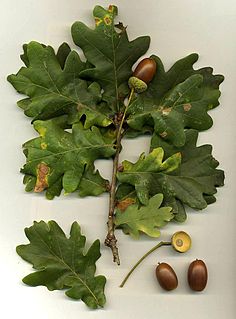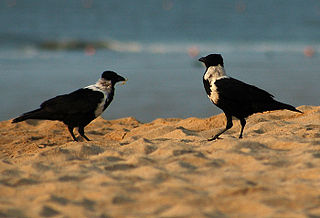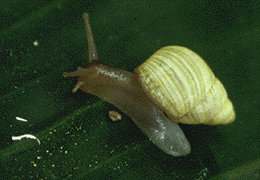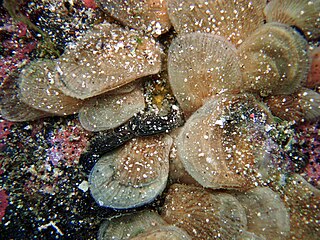
An oak is a tree or shrub in the genus Quercus of the beech family, Fagaceae. There are approximately 600 extant species of oaks. The common name "oak" also appears in the names of species in related genera, notably Lithocarpus, as well as in those of unrelated species such as Grevillea robusta and the Casuarinaceae (she-oaks). The genus Quercus is native to the Northern Hemisphere, and includes deciduous and evergreen species extending from cool temperate to tropical latitudes in the Americas, Asia, Europe, and North Africa. North America contains the largest number of oak species, with approximately 90 occurring in the United States, while Mexico has 160 species of which 109 are endemic. The second greatest center of oak diversity is China, which contains approximately 100 species.

A seashell or sea shell, also known simply as a shell, is a hard, protective outer layer created by an animal that lives in the sea. The shell is part of the body of the animal. Empty seashells are often found washed up on beaches by beachcombers. The shells are empty because the animal has died and the soft parts have been eaten by another animal or have decomposed.

The collared crow, also known as the ring-necked crow or white-collared crow, is a member of the family Corvidae native to China and north of Vietnam.

The radjah shelduck, is a species of shelduck found mostly in New Guinea and Australia, and also on some of the Moluccas. It is known alternatively as the raja shelduck, black-backed shelduck, or in Australia as the Burdekin duck.

Oʻahu tree snails, genus Achatinella, form a large genus of colorful, tropical, tree-living, air-breathing, land snails, arboreal pulmonate gastropod mollusks in the family Achatinellidae.

The southern river otter is a species of otter that lives in Chile and Argentina. Although called a "river otter", it inhabits both marine and freshwater environments. It sometimes is considered a subspecies of Lontra canadensis. The southern river otter is listed as endangered, due to illegal hunting, water pollution, and habitat loss.

Terrestrial animals are animals that live predominantly or entirely on land, as compared with aquatic animals, which live predominantly or entirely in the water, or amphibians, which rely on a combination of aquatic and terrestrial habitats. Terrestrial invertebrates include ants, flies, crickets, grasshoppers and spiders.

Henry Augustus Pilsbry was an American biologist, malacologist and carcinologist, among other areas of study. He was a dominant presence in many fields of invertebrate taxonomy for the better part of a century. For much of his career, his authority with respect to the classification of certain substantial groups of organisms was unchallenged: barnacles, chitons, North American terrestrial mollusks, and others.

The tree of life or universal tree of life is a metaphor, model and research tool used to explore the evolution of life and describe the relationships between organisms, both living and extinct, as described in a famous passage in Charles Darwin's On the Origin of Species (1859).
The affinities of all the beings of the same class have sometimes been represented by a great tree. I believe this simile largely speaks the truth.

The mangrove pitta is a species of passerine bird in the Pittidae family native to the eastern Indian Subcontinent and western Southeast Asia. It is part of a superspecies where it is placed with the Indian pitta, the fairy pitta and the blue-winged pitta but has no recognized subspecies. A colourful bird, it has a black head with brown crown, white throat, greenish upper parts, buff underparts and reddish vent area. Its range extends from India to Malaysia and Indonesia. It is found in mangrove and nipa palm forests where it feeds on crustaceans, mollusks and insects. Its call, sometimes rendered as wieuw-wieuw, is sung from a high perch on a mangrove tree.

The emerald green snail, green tree snail, or Manus green tree snail, scientific name Papustyla pulcherrima, sometimes listed as Papuina pulcherrima, is a species of large, air-breathing tree snail, a terrestrial pulmonate gastropod mollusk in the family Camaenidae.
Tree snail is a common name that is applied to various kinds of tropical air-breathing land snails, pulmonate gastropod mollusks that have shells, and that live in trees, in other words, are exclusively arboreal in habitat.

Partulidae is a family of air-breathing land snails, terrestrial gastropod mollusks in the superfamily Partuloidea. The family is endemic to Pacific islands.

A micromollusk is a shelled mollusk which is extremely small, even at full adult size. The word is usually, but not exclusively, applied to marine mollusks, although in addition, numerous species of land snails and freshwater mollusks also reach adult size at very small dimensions.

Partula is a genus of air-breathing tropical land snails, terrestrial pulmonate gastropod mollusks in the family Partulidae. Many species of Partula are known under the general common names "Polynesian tree snail" and "Moorean viviparous tree snail". Partulids are distributed across 5,000 sq mi (13,000 km2) of Pacific Ocean islands, from the Society Islands to New Guinea.
There are numerous species of plants and animals on the island of Dominica. Some of these are island endemics, while others are also found on other Caribbean islands; some are also found on the mainland.

Isognomon is a genus of marine bivalve mollusks which is related to the pearl oysters.
John Bayard Burch is an American zoologist, a biology professor at the University of Michigan, and the Curator of Mollusks at the University of Michigan Museum of Zoology. His research interests are broad, and have encompassed not only the anatomy, systematics, and genetics of mollusks, but also various aspects of zoogeography and parasitology. He has engaged in extensive fieldwork around the world, usually collecting mollusks, especially freshwater and terrestrial species. Some sample taken in Tahiti in 1970 have proven to be of importance in efforts to conserve vanishing kinds of the land snail Partula.
Flavum is a Latin word meaning "yellow". It is often used in taxonomy for species names typically in scientific names for animals and plants to refer to the flower colour or other aspect of the species.

Amphidromus thachi is a species of medium-sized air-breathing tree snail, an arboreal gastropod mollusk in the family Camaenidae.















